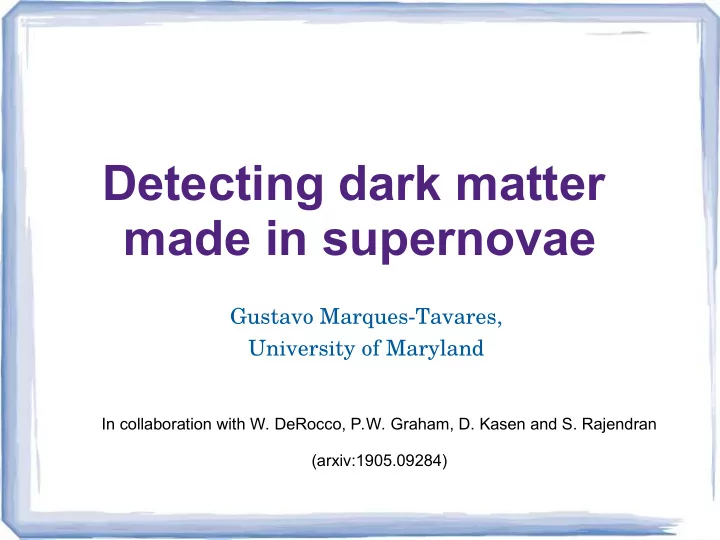

Detecting dark matter made in supernovae G u s t a v o Ma r q u e s - T a v a r e s , U n i v e r s i t y o f Ma r y l a n d In collaboration with W. DeRocco, P.W. Graham, D. Kasen and S. Rajendran (arxiv:1905.09284)
Dark matter direct detection ? arxiv: 1709.00688
Challenges for sub-GeV DM ● Galactic DM velocity: v ~ 10 -3 – Kinetic energy ~ 10 -6 m dm < keV ● Backgrounds increase
Challenges for sub-GeV DM ● Galactic DM velocity: v ~ 10 -3 – Kinetic energy ~ 10 -6 m dm < keV ● Backgrounds increase
Astrophysical sources of DM ● Look for astrophysical environments where T ~ m dm , where DM can be produced ● Supernovae are an ideal candidate, the central region gets to ~ 50 MeV temperatures for timescales of O(10s) ● Promising idea, but must check if the flux of dark matter made in supernovae is sufficiently large.
Focus on simplified model ● Fermionic DM interacting via ● UV inspiration
Core-collapse supernovae
Proto-neutron star
Important effects ● Dark matter is only mildly relativistic: – delayed arrival – signal spread ● In most of relevant parameter space dark matter is diffusively trapped: not all DM that is produced will make it out
Velocity effects
Velocity effects SN1987a was 55 kpc away (~ 150000 years) F l u x d i l u t e d b y
Diffuse background ● CCSN occur at a rate of ~ 2 per century in our galaxy ● Each signal lasts for 1000s of years, signals from many old supernovae overlap ● Similar to SN neutrino background, except that origin is galactic
Trapped regime We computed the flux with a Monte Carlo simulation, but many aspects can be understood analitically using a radial freeze-out approach (assuming static profile) Freeze-out in time Freeze-out in radius Rate vs Timescale Mean free path vs Size e.g. e.g.
Freeze-out radii Number Sphere R N Energy Sphere R E Scattering Sphere R T
Diffusion Only one type of interaction Diffusion The total distance traveled to move λ ann is enhanced by
Effective mean free path Freeze-out condition:
Compare with Monte Carlo
Flux on Earth
Energy sphere ● In the simulation we do not keep track of momentum information since we are mostly interested in the tail of the distribution. ● We set the spectrum using the temperature of the energy sphere instead
Signals For most of the parameter space: For electron scattering: Large backgrounds from neutrinos
Signals For most of the parameter space: For electron scattering: Large backgrounds from neutrinos For nuclear scattering: With Liquid Xenon targets: Bonus:
Projected sensitivity
Projected sensitivity
Conclusions ● Supernovae can be sources of relativistic DM ● Liquid Xe detectors are sensitive to sub-GeV dark matter made in SN ● Can be extended to your favorite sub-GeV DM, as long as DM couples to electrons and/or nuclei
Recommend
More recommend